汽车精冲部件以及材料简介Automotive fine blanking parts
- 格式:pdf
- 大小:230.73 KB
- 文档页数:3
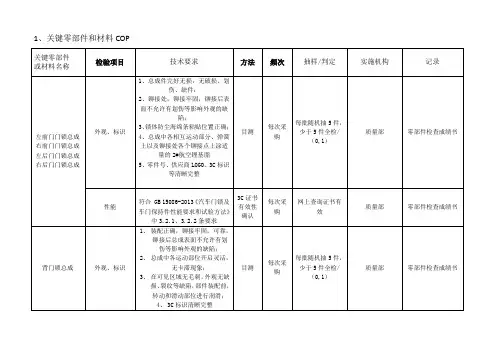
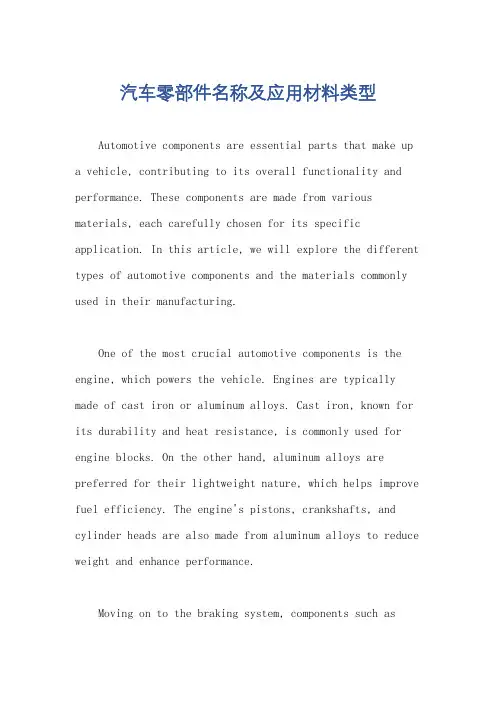
汽车零部件名称及应用材料类型Automotive components are essential parts that make up a vehicle, contributing to its overall functionality and performance. These components are made from various materials, each carefully chosen for its specific application. In this article, we will explore the different types of automotive components and the materials commonly used in their manufacturing.One of the most crucial automotive components is the engine, which powers the vehicle. Engines are typically made of cast iron or aluminum alloys. Cast iron, known for its durability and heat resistance, is commonly used for engine blocks. On the other hand, aluminum alloys are preferred for their lightweight nature, which helps improve fuel efficiency. The engine's pistons, crankshafts, and cylinder heads are also made from aluminum alloys to reduce weight and enhance performance.Moving on to the braking system, components such asbrake discs and drums are typically made from cast iron due to its excellent heat dissipation properties. Cast iron can withstand high temperatures generated during braking, ensuring reliable and consistent performance. Brake pads,on the other hand, are composed of friction materials such as ceramic, semi-metallic, or organic compounds. These materials are chosen for their ability to provide optimal braking performance, durability, and noise reduction.Suspension systems play a crucial role in providing a comfortable and stable ride. Components like control arms, springs, and shock absorbers are commonly made from steel alloys. Steel offers excellent strength and durability, allowing these components to withstand the constant stress and impact encountered on the road. Additionally, somehigh-performance vehicles may incorporate lightweight materials such as carbon fiber or aluminum alloys in their suspension systems to further enhance performance.The body of a vehicle is composed of various components, including panels, frames, and doors. Traditionally, these components were made from steel due to its strength andaffordability. However, advancements in technology have led to the use of alternative materials such as aluminum,carbon fiber, and high-strength steel. Aluminum offers weight reduction benefits, while carbon fiber provides exceptional strength-to-weight ratio. High-strength steel, on the other hand, combines strength and formability, making it ideal for structural components.Interior components of a vehicle, such as seats, dashboard, and trim, are made from a wide range ofmaterials to provide comfort, aesthetics, and durability. Seats are typically upholstered with materials like leather, fabric, or synthetic fibers, offering a balance between comfort and luxury. Dashboard and trim components are often made from plastic materials due to their versatility, easeof molding, and cost-effectiveness. However, premiumvehicles may incorporate wood, aluminum, or carbon fiber trims to enhance the interior's aesthetics and perceived quality.Lastly, electrical and electronic components areintegral to modern vehicles. Wiring harnesses, connectors,and circuit boards are commonly made from copper and various types of plastics. Copper is an excellent conductor of electricity, ensuring efficient transmission ofelectrical signals. Plastics are used for their insulating properties and ability to withstand high temperatures. Additionally, electronic components such as sensors and control modules are made from semiconductor materials like silicon or gallium arsenide.In conclusion, automotive components are made from a wide variety of materials, each carefully selected based on its specific application. From the engine to the braking system, suspension, body, interior, and electronics, different materials are used to ensure optimal performance, durability, and safety. The constant advancements in material science and manufacturing techniques continue to push the boundaries of automotive component design, leading to more efficient, lightweight, and technologically advanced vehicles.。
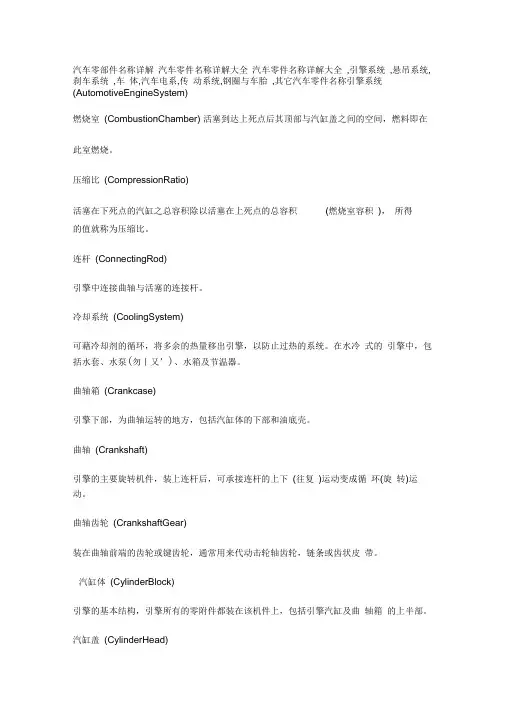
汽车零部件名称详解汽车零件名称详解大全汽车零件名称详解大全,引擎系统,悬吊系统,刹车系统,车体,汽车电系,传动系统,钢圈与车胎,其它汽车零件名称引擎系统(AutomotiveEngineSystem)燃烧室(CombustionChamber) 活塞到达上死点后其顶部与汽缸盖之间的空间,燃料即在此室燃烧。
压缩比(CompressionRatio)活塞在下死点的汽缸之总容积除以活塞在上死点的总容积(燃烧室容积),所得的值就称为压缩比。
连杆(ConnectingRod)引擎中连接曲轴与活塞的连接杆。
冷却系统(CoolingSystem)可藉冷却剂的循环,将多余的热量移出引擎,以防止过热的系统。
在水冷式的引擎中,包括水套、水泵(勿丨又’)、水箱及节温器。
曲轴箱(Crankcase)引擎下部,为曲轴运转的地方,包括汽缸体的下部和油底壳。
曲轴(Crankshaft)引擎的主要旋转机件,装上连杆后,可承接连杆的上下(往复)运动变成循环(旋转)运动。
曲轴齿轮(CrankshaftGear)装在曲轴前端的齿轮或键齿轮,通常用来代动击轮轴齿轮,链条或齿状皮带。
汽缸体(CylinderBlock)引擎的基本结构,引擎所有的零附件都装在该机件上,包括引擎汽缸及曲轴箱的上半部。
汽缸盖(CylinderHead)引擎的盖子及封闭汽缺的机件,包括水套和汽门及冷却片。
爆震(Detonation) 为火焰的撞击或爆声,在火花点火引擎的燃烧室内,因为压过的空气燃料混合气会自燃,于是使部份未燃的混合气产生二次点火(在火星塞点火之后),因而发出了爆声。
排气量(Displacemint)在引擎的某一循环运作中,能将全部空气及混合气送入所有汽缸的能力,也是指一个活塞从一个行程运作至另一行程所能排的体积。
引擎(Engine)一种能将热能转变为机械能的机械:一种可将燃料燃烧产生机械动力的装置; 有时可视为一种发动机。
风扇皮带(FanBelt)一种由曲轴带动的皮带,其主要目的是带动引擎风扇和水泵。

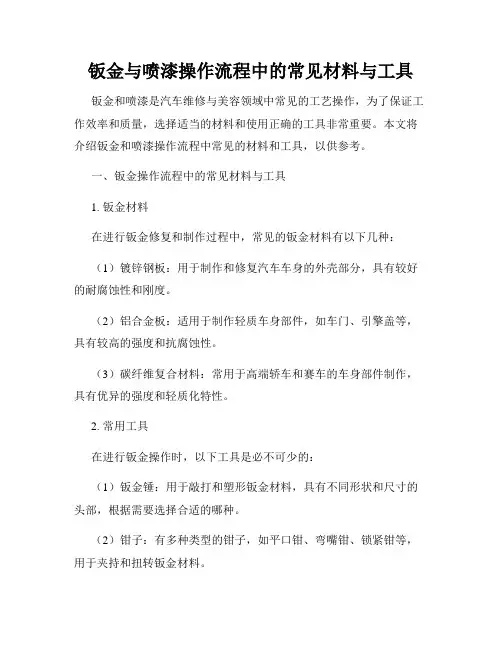
钣金与喷漆操作流程中的常见材料与工具钣金和喷漆是汽车维修与美容领域中常见的工艺操作,为了保证工作效率和质量,选择适当的材料和使用正确的工具非常重要。
本文将介绍钣金和喷漆操作流程中常见的材料和工具,以供参考。
一、钣金操作流程中的常见材料与工具1. 钣金材料在进行钣金修复和制作过程中,常见的钣金材料有以下几种:(1)镀锌钢板:用于制作和修复汽车车身的外壳部分,具有较好的耐腐蚀性和刚度。
(2)铝合金板:适用于制作轻质车身部件,如车门、引擎盖等,具有较高的强度和抗腐蚀性。
(3)碳纤维复合材料:常用于高端轿车和赛车的车身部件制作,具有优异的强度和轻质化特性。
2. 常用工具在进行钣金操作时,以下工具是必不可少的:(1)钣金锤:用于敲打和塑形钣金材料,具有不同形状和尺寸的头部,根据需要选择合适的哪种。
(2)钳子:有多种类型的钳子,如平口钳、弯嘴钳、锁紧钳等,用于夹持和扭转钣金材料。
(3)冲击螺母枪:用于快速拆卸和安装螺母,提高工作效率。
(4)气动切割机:可用于精确切割和修复钣金材料,提供高效和准确的切割。
(5)电动砂轮机:用于打磨和修复钣金表面,除去划痕和凹陷,使其平整光滑。
二、喷漆操作流程中的常见材料与工具1. 喷漆材料在进行喷漆操作时,常见的喷漆材料有以下几种:(1)底漆:用于保护车身钣金表面,提供良好的附着力和耐久性。
(2)面漆:用于给车身上色,丰富车身的外观效果和质感。
(3)清漆:用于保护面漆,提供额外的光泽和耐久性。
(4)蒸汽:用于稀释和调整喷漆材料的粘度和流动性。
2. 常用工具在进行喷漆操作时,以下工具是必不可少的:(1)喷枪:用于将喷漆材料均匀地涂覆在车身表面,有风压和重力两种类型的喷枪可供选择。
(2)油石砂纸:用于打磨和平整钣金表面,去除划痕和凹陷。
(3)面具和防护眼镜:用于保护操作者的呼吸系统和眼睛,避免吸入有害气体或喷漆溅射。
(4)喷漆间隔纸:在涂覆多层面漆时,用于确保每次涂覆之间的干燥和平整。

基于Deform的精冲模具磨损特性研究∗史双喜;李福涛【摘要】Fine blanking die wear model for finite element analysis was built.Simulation was carried out in normal tem⁃perature for analyzing fine blanking punch wear by using the finite element software Deform⁃3D.The influences on the die wear by process parameters,such as die material hardness,coefficient of friction between blank and die,and the formingload were analyzed.The results show that the punch edge wear is serious,but the amount of wear in the convex side is small.The maximum wear depth is decreased with the increase of the hardness of die material,and increased with the in⁃crease of friction coefficient.The counterforce is also the important factor influencing the punch wear,the maximum wear depth is increased with the increase of the counterforce.%建立精冲模具磨损有限元分析模型,采用有限元软件Deform⁃3D 对常温下的精冲凸模磨损进行仿真分析,研究模具材料的硬度、毛坯与模具间摩擦因数和成型载荷等工艺参数对模具磨损的影响。
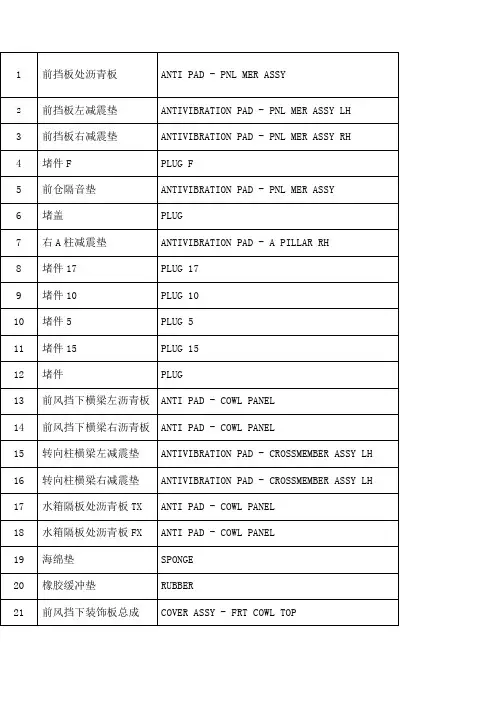
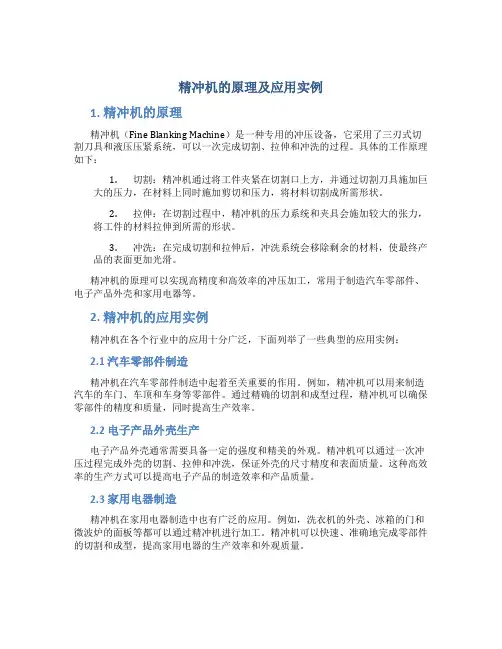
精冲机的原理及应用实例1. 精冲机的原理精冲机(Fine Blanking Machine)是一种专用的冲压设备,它采用了三刃式切割刀具和液压压紧系统,可以一次完成切割、拉伸和冲洗的过程。
具体的工作原理如下:1.切割:精冲机通过将工件夹紧在切割口上方,并通过切割刀具施加巨大的压力,在材料上同时施加剪切和压力,将材料切割成所需形状。
2.拉伸:在切割过程中,精冲机的压力系统和夹具会施加较大的张力,将工件的材料拉伸到所需的形状。
3.冲洗:在完成切割和拉伸后,冲洗系统会移除剩余的材料,使最终产品的表面更加光滑。
精冲机的原理可以实现高精度和高效率的冲压加工,常用于制造汽车零部件、电子产品外壳和家用电器等。
2. 精冲机的应用实例精冲机在各个行业中的应用十分广泛,下面列举了一些典型的应用实例:2.1 汽车零部件制造精冲机在汽车零部件制造中起着至关重要的作用。
例如,精冲机可以用来制造汽车的车门、车顶和车身等零部件。
通过精确的切割和成型过程,精冲机可以确保零部件的精度和质量,同时提高生产效率。
2.2 电子产品外壳生产电子产品外壳通常需要具备一定的强度和精美的外观。
精冲机可以通过一次冲压过程完成外壳的切割、拉伸和冲洗,保证外壳的尺寸精度和表面质量。
这种高效率的生产方式可以提高电子产品的制造效率和产品质量。
2.3 家用电器制造精冲机在家用电器制造中也有广泛的应用。
例如,洗衣机的外壳、冰箱的门和微波炉的面板等都可以通过精冲机进行加工。
精冲机可以快速、准确地完成零部件的切割和成型,提高家用电器的生产效率和外观质量。
2.4 钣金加工精冲机在钣金加工中起到了关键的作用。
通过精冲机的应用,可以实现各种形状的钣金件的制造。
例如,航空航天领域中的飞机外壳、电力工业中的开关箱等都是通过精冲机进行加工的。
精冲机的高精度和高效率使得钣金加工变得更加简单和快速。
3. 总结精冲机作为一种专用的冲压设备,通过独特的工作原理实现高精度和高效率的冲压加工。

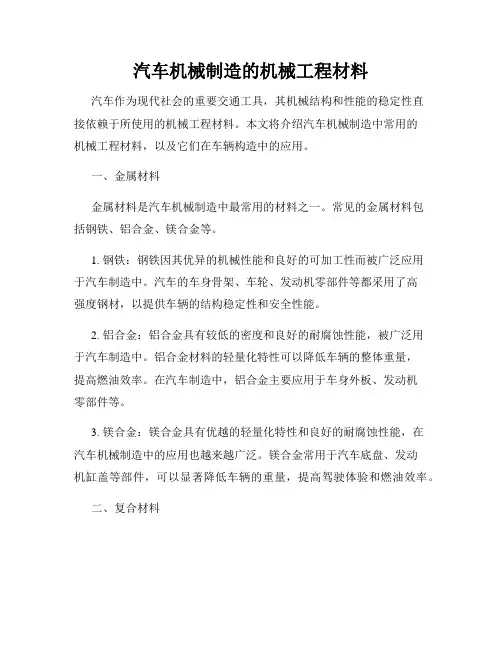
汽车机械制造的机械工程材料汽车作为现代社会的重要交通工具,其机械结构和性能的稳定性直接依赖于所使用的机械工程材料。
本文将介绍汽车机械制造中常用的机械工程材料,以及它们在车辆构造中的应用。
一、金属材料金属材料是汽车机械制造中最常用的材料之一。
常见的金属材料包括钢铁、铝合金、镁合金等。
1. 钢铁:钢铁因其优异的机械性能和良好的可加工性而被广泛应用于汽车制造中。
汽车的车身骨架、车轮、发动机零部件等都采用了高强度钢材,以提供车辆的结构稳定性和安全性能。
2. 铝合金:铝合金具有较低的密度和良好的耐腐蚀性能,被广泛用于汽车制造中。
铝合金材料的轻量化特性可以降低车辆的整体重量,提高燃油效率。
在汽车制造中,铝合金主要应用于车身外板、发动机零部件等。
3. 镁合金:镁合金具有优越的轻量化特性和良好的耐腐蚀性能,在汽车机械制造中的应用也越来越广泛。
镁合金常用于汽车底盘、发动机缸盖等部件,可以显著降低车辆的重量,提高驾驶体验和燃油效率。
二、复合材料复合材料是指由两种或两种以上不同性质的材料经过复合形成的新材料。
在汽车机械制造领域,复合材料的应用越来越广泛,主要有碳纤维复合材料和玻璃纤维复合材料等。
1. 碳纤维复合材料:碳纤维复合材料具有极高的强度和刚度,同时具备较低的密度。
在汽车制造中,碳纤维复合材料主要应用于车身结构、底盘部件等。
它的轻量化特性可以显著减少车辆的自重,提高燃油经济性。
2. 玻璃纤维复合材料:玻璃纤维复合材料具有良好的机械性能和耐腐蚀性能,被广泛应用于汽车制造中。
在车身制造中,玻璃纤维复合材料常用于车身内外板等部件,以提供良好的抗冲击性和刚性。
三、塑料材料塑料材料常用于汽车内饰件、保险杠、车灯外壳等部件的制造中。
塑料材料具有良好的可塑性和成型性,可以满足复杂零部件的制造需求。
塑料材料一般分为热塑性塑料和热固性塑料两类。
热塑性塑料可在一定温度范围内多次加热软化并成型,常用于汽车内饰件的制造。
而热固性塑料在一次加热后固化成固体,具有良好的耐高温性能,常用于汽车外部部件的制造。

汽车高分子材料------------------------------------------作者------------------------------------------日期汽车高分子材料培训课程讲义2005.1目录第一篇汽车塑料基础知识一、汽车塑料制品发展过程二、汽车用塑料主要特点三、我国汽车塑料制品发展现状与趋势四、塑料在轿车饰件的应用第二篇汽车用塑料制品与材料一、聚氨酯泡沫塑料制品二、工程塑料汽车零部件三、塑料基复合材料汽车制品四、塑料及树脂缩写代号五、塑料的组成六、汽车塑料制品常用聚合物树脂七、汽车塑料制品的主要助剂八、汽车塑料制品的常用填充物和增强物九、汽车塑料的需要的主要性能指标第三篇汽车饰件用塑料及其制品一、汽车饰件与塑料二、汽车用聚氨酯泡沫塑料三、汽车软饰件与塑料四、反应注射模塑及制品第四篇 汽车常用塑料及饰件 一、聚丙烯塑料汽车塑料件 二、聚乙烯汽车塑料件 三、改性聚苯乙烯塑料 四、聚氯乙烯车塑料件第 五篇 塑料结构制品材料的选用原则 一、塑料材料选用的注意事项 二、塑料材料的选用范围 三、常用零部件的选用方法实例 第六 篇 塑料制品的设计要求 一、设计的工艺性 二、典型零部件的设计第一篇 汽车塑料基础知识一、汽车塑料制品发展过程1.可清洁性--轻量性--减震性---经济性---资源性二、汽车用塑料主要特点:高分子汽车材料有很多以往传统材料没有的优点。
主要表现在重量轻、有良好的外观装饰效果、有多种实际应用功能、有良好的理化性能、容易加工成型、节约能源,可持续利用等各方面。
高分子汽车材料的主要特点如下。
1.重量轻高分子汽车材料最突出的优点之一就是具有轻质高强度的特性。
由于各种塑料的平均比重只有一般普通钢材的15-20%,也比一般木材轻。
这一特点对高档大型轿车尤其有突出的优点,可以减去大量的自重。
2.良好的加工性能高分子汽车材料具有非常好的加工性能。
由于高分子汽车材料的可塑性和与其它材料之间良好的兼容结合性能,可以利用不同的材料组分,借助于各种现代化的成型加工机械,通过挤出、注塑、压延、模塑、吹塑等方法加工成具有各种不同形状、不同性能、不同颜色的、不同功能的高分子汽车材料,如,直接挤成管材、型材、板材,注射成有各种造型的制品、压延加工成薄膜等,还可根据需要制成各种颜色、有夹层、中空、放嵌件等各种产品,还可根据要求进行二次加工,如机械制品样的车削、冲切、裁剪、焊接、也可热熔、冷锯、复合等。
发动机主要部件的材质材料简单介绍发动机由发动机机体、曲轴连杆机构、配气机构、润滑系、冷却系、燃料供给系、点火系、(柴油机没有点火系)和启动装置组成.1、机体:包括汽缸盖、汽缸体、汽缸垫、曲轴箱、油底壳等.机体是发动机各机构、各系统和部件的安装基础.2、曲轴连杆机构:包括活塞、活塞环、活塞、连杆、曲轴、轴瓦、飞轮等.它是将热能转换成机械能的机构,并把活塞的往复运动变为曲轴的旋转运动输出动力.3、配气机构:包括进气门、排气门、摇臂、推杆、挺杆、凸轮轴、曲轴齿轮及凸轮轴正时齿轮等.4、润滑系:包括机油泵、集滤器、限压阀、机油粗滤清器、机油细滤清器、油道、机油压力表、油管和机油冷却系等.5、冷却系:包括水泵、风扇、散热器、分水管、汽缸体及盖的水套、节温器、百叶窗、水温表、放水阀等.6、供给系:包括汽油箱、汽油泵、汽油滤清器、化油器、空气滤清器、进气管、汽油表、排气管、排气消声器等.7、点火系:包括蓄电池、发电机、断电器、分电器、点火线圈,点火开关、电流表、高压线、火花塞等.8启动装置:包括起动机及其附属装置.下面要说的只是1、2、3、这三个方面的内容:缸体:缸体材料应具有足够的强度、良好的浇铸性和切削性,且价格要低,因此常用的缸体材料是铸铁、合金铸铁。
铸铁有着很多先天的不足,重量大、散热性差、摩擦系数高等等。
铝合金缸体重量轻,导热性良好,冷却液的容量可减少。
启动后,缸体很快达到工作温度,并且和铝活塞热膨胀系数完全一样,受热后间隙变化小,可减少冲击噪声和机油消耗。
而且和铝合金缸盖热膨胀相同,工作可减少冷热冲击所产生的热应力。
同样铝也存在着缺点,就是容易和燃烧时产生的水发生化学反应,耐腐性不及铸铁缸体。
汽缸与汽缸套水冷式式发动机汽缸有三种结构型式:无缸套、干式缸套、湿式缸套。
无缸套汽缸:汽缸筒与缸体制成一体,与活塞接触的内表面没有镶套,多数铸铁缸体汽油机采用这种型式,它结构简单,加工面少,汽缸刚度也较好。
干式缸套的外表不直接和冷却液接触,缸套的强度和刚度大,但缸套与缸体采用过盈配合,拆装不方便。
汽车机械制造的先进机械材料随着汽车工业的不断发展和技术的进步,汽车的机械制造过程中使用的材料也在不断地更新和改进。
先进的机械材料在汽车制造中起着至关重要的作用,它们不仅能提高汽车的性能和安全性,还可以延长汽车的使用寿命。
本文将介绍几种在汽车机械制造中常用的先进机械材料,并探讨它们的优势和应用。
一、高强度钢材高强度钢材是目前汽车制造中广泛应用的一种先进材料。
相对于传统的普通钢材,高强度钢材具有更高的强度和硬度,能够承受更大的冲击和拉伸力。
高强度钢材在汽车制造中主要用于车身骨架和结构件的制造,能够提高汽车的整体刚性和安全性能,有效提升汽车在碰撞中的抗冲击能力。
此外,高强度钢材还具有重量轻、耐腐蚀等特点,能够降低汽车的整体重量和燃油消耗,提高燃油经济性。
二、铝合金材料铝合金材料是另一种常用的先进机械材料。
与传统的铁材相比,铝合金具有更低的密度和更高的强度,能够实现汽车轻量化的设计目标。
在汽车制造中,铝合金常常被用于发动机部件、车身结构件、制动系统等关键部件的制造。
采用铝合金材料可以降低整车重量,提高车辆的操控性能和燃油经济性,同时还能减少废气排放和环境污染。
然而,铝合金也具有较高的成本和加工难度,需要在制造工艺上加以解决。
三、碳纤维复合材料碳纤维复合材料是近年来汽车制造领域中备受关注的先进材料。
与传统的金属材料相比,碳纤维复合材料具有更高的强度和刚度,同时具备重量轻、耐腐蚀等特点。
由于碳纤维复合材料具有优异的力学性能,它被广泛应用于高端车型和赛车中。
采用碳纤维复合材料可以实现轻量化设计,提高汽车的加速性能和操控性能,同时还能降低燃油消耗和排放量。
然而,碳纤维复合材料的成本较高,制造工艺也相对复杂,需要在应用中平衡成本和性能。
四、陶瓷材料陶瓷材料在汽车机械制造中也有重要的应用。
具有低密度、高硬度、高温稳定性等特点的陶瓷材料,可以用于制造发动机部件(如活塞、气门、气缸套等)和排气系统中的涡轮叶片等。
陶瓷材料具有出色的高温性能和耐磨损性能,能够承受高温高压环境下的严苛条件。